Here's a sample turn to give you an idea of what can happen. Jack and Jill are opposing commanders in the Battle of Marathon. Jill is in charge of a command of Greek warriors. She knows that, historically, the Greeks rushed at the Persians so they wouldn't be exposed to a lot of arrow fire, so she decides to follow their example. She'll try and get to the enemy as quickly as she can, where her heavily armored Hoplites will have the advantage.
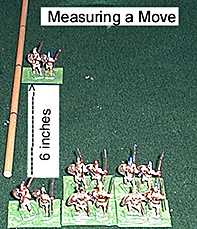
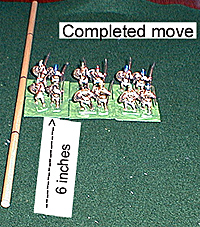 Greek Movement:
Greek Movement:
Jill's infantry can move up to 6",
she decides that all of her units will move the full 6"
towards the enemy. She uses a measuring stick that is marked
in 3" intervals. The stick is placed in front of her lead
unit. One stand is moved forward 6" (2 marks on the stick).
The rest of the unit is then moved next to the first. She repeats
the process for all of her units.
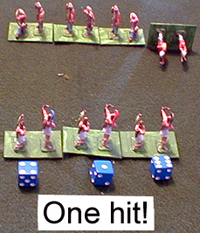 Greek Shooting:
Greek Shooting:
Her lead unit is three stands of Greek bowmen. Jill can shoot at the enemy if they are within 12". She checks the range to the enemy, they are closer than 12" so she can shoot. She rolls one die for each stand: 4, 1, 6. She need a six to his, so the Jack, the Persian commander, loses one of his stands.
Persian Move:
It's Jack's turn now, but he's in no hurry to close with the Greeks. He decides not to move any of his units.
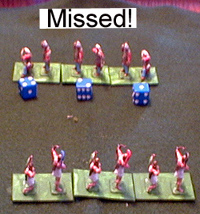 Persian Shooting:
Persian Shooting:
Jack still has three stands of bowmen
facing the Greek archers. They are in range, so he rolls three
dice: 4, 2, 1. They all missed (he needed to roll a six). Better
spend more time on the archery range, Jack.
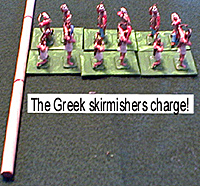 Charging:
Charging:
Now both sides can decide if they want to charge
into hand-to-hand combat. Both sides have skirmishers, which
aren't very good at this kind of fighting. But Jill has some
hoplites behind her archers, and she wants to get the Persian
skirmishers out of the way, so she decides to charge. She checks
the range - she can only charge if the Persians are within 6".
They are, so she moves her archers into contact with the Persian
archers. They move to melee.
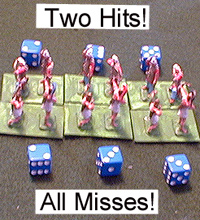 Melee:
Melee:
Each side has three stands, so they each roll
three dice. Normally skirmishers only hit with a 6, but since
they are fighting skirmishers their chances are much better -
4, 5, or 6 will hit. These skirmishers won't be around for long.
Jack rolls: 2, 6, 5. Jill will lose two stands, leaving her with
just one. But according to the rules when a unit is reduced to
just one stand, the last stand is immediately removed, so she
will lose all three. But they still get to fight in this melee.
Her roll: 2, 3, 3. All misses.
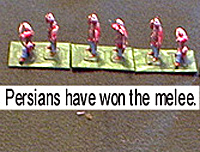 The Persians have won this melee.
If both sides had stands surviving they would have been locked
in combat and would have waited until the melee phase of the
next turn to continue the fight.
The Persians have won this melee.
If both sides had stands surviving they would have been locked
in combat and would have waited until the melee phase of the
next turn to continue the fight.
Jill isn't too disappointed, though. She knows her hoplites will make short work of the Persian skirmishers, and they are ready to move on the next turn. Wargaming 101: Basics for Beginners
Back to Table of Contents -- Junior General Report #1
Back to Junior General Report List of Issues
Back to MagWeb.com Magazine List
© Copyright 2002 by Matt Fritz.
This article appears in MagWeb.com (Magazine Web) on the Internet World Wide Web.
Other articles covering military history and related topics are available at http://www.magweb.com